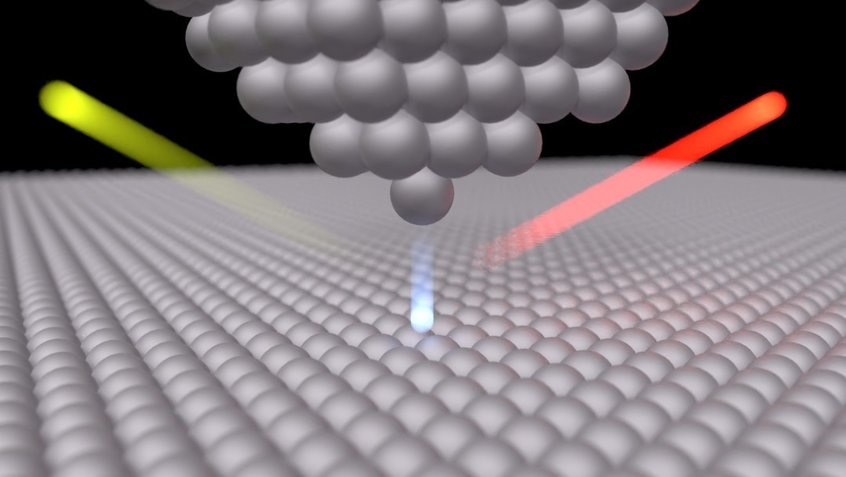May 22 2019
Quantum physics could be used to guarantee secure information technology in the future. In order to realize this, photons—individual particles of light—are used to securely transmit data.
 Controlled quantum signals: When electrons (light blue) tunnel from the tip of a scanning tunnelling microscope to a sample, photon pairs (yellow and red) are generated more frequently than previously assumed. These open up the possibility in quantum communication of transmitting information with one photon while verifying the transmission with the other. (Image credit: Klaus Kuhnke/MPI für Festkörperforschung)
Controlled quantum signals: When electrons (light blue) tunnel from the tip of a scanning tunnelling microscope to a sample, photon pairs (yellow and red) are generated more frequently than previously assumed. These open up the possibility in quantum communication of transmitting information with one photon while verifying the transmission with the other. (Image credit: Klaus Kuhnke/MPI für Festkörperforschung)
Outcomes of a study by physicists from the Max Planck Institute for Solid State Research could have a vital role to play. They accidentally chanced upon a light source that produces a photon pair using the energy of an electron. One of the photons has the ability to act as a carrier of the vulnerable quantum information, and the other one as a messenger to offer prior notification of its twin.
Contrary to quantum communication, a cook has the liberty of being able to check whether all the ingredients he or she requires for a recipe are in the closet. Anyway, flour does not get spoiled immediately after someone has a look at it. However, a physicist making attempts to test whether a process for transmitting quantum information has worked as intended is in a much delicate position. Quantum objects tend to change their state upon being observed, or measured.
In quantum communication, this renders it challenging to control the information that the photons transmit. However, that is the crucial point. The quantum information transported by photons can be destroyed by every contact with the environment. Moreover, sources of individual light particles usually produce single photons only very rarely. So how can it be guaranteed that a photon is on its way without being measured? The solution is to use pairs of photons. One of the photons might be able to act as a messenger for the other.
An Unexpected Source of Photon Pairs
At present, researchers at the Max Planck Institute for Solid State Research have identified an unpredicted source of such photon pairs—a scanning tunnelling microscope. In general, scientists use a microscope of this type to investigate the surfaces of conducting or semiconducting materials. The microscope is founded on an effect called quantum tunnelling. This explains how electrons have a specific probability crossing a barrier which, according to classical physics, they would not be able to pass through normally. In a scanning tunnelling microscope, when a voltage is applied to a metallic tip, electrons tunnel over a short distance to a sample. Light is generated when an electron loses energy at the time of the tunnelling process.
It is exactly this light that the Stuttgart physicists have been analyzing for several years. Their study has now resulted in an astonishing observation: at the time of tunnelling, apart from individual light particles, photon pairs are also created, at a rate 10,000 times higher than that predicted by theory.
According to theory, the probability of a photon pair forming is so low that we should never see it. But our experiment shows that photon pairs are being generated at a much higher rate. That was a huge surprise for us.
Christopher Leon, Scientist, Max Planck Institute for Solid State Research
The physicists used two detectors to measured the photon pairs, enabling them to measure the interval of time between the arriving photons. “At the moment when a photon pair forms in a tunnelling junction, they are less than 50 trillionths of a second apart,” explains the leading scientist Klaus Kuhnke. Currently, it is not feasible to say whether the photons are indeed generated at the same time or in quick succession. The detectors’ resolution is not yet sufficiently high.
New Applications for Tunnelling Junctions
The study outcomes pave the way for new applications in photonics and quantum communication for tunnelling junctions. Although researchers are already aware of the processes that produce photon pairs, a majority of them use intense laser light. By contrast, the technique devised by the Max Planck researchers from Stuttgart is completely electronic.
Moreover, the components that are required are extremely small, and the process occurs on an atomic scale. This suggests that even the new light source could be used in future generations of computer chips, substituting electronic components with optical equivalents. One benefit of using photons is that they ensure rapid and lossless transmission of data. The photon pairs in the experiment performed by the Stuttgart scientists were very fast; however, the very low temperatures and the ultra-high vacuum necessitated by the experiment are still practically difficult to achieve.
For the researchers, the next step is to identify whether the measurement of one photon has a direct impact on the state of the other. If this is so, the light particles would get entangled. Entangled particles of this type play a vital role in quantum cryptography. The study outcomes also give way to basic questions related to the formation of photon pairs. To date, the process has been disregarded from a theoretical perspective. “The fact that photon pairs are generated indicates that a complicated process must be taking place,” stated theorist Olle Gunnarsson. Klaus Kern, Director of the Max Planck Institute for Solid State Research, agrees that the process is exciting: “It’s thrilling because it opens up a new perspective on how light is produced.”